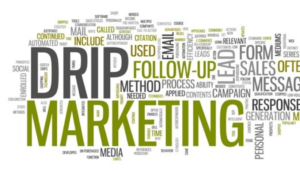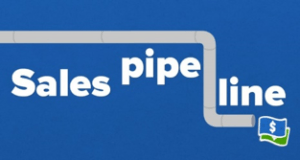Need A Better Sales Pipeline ?
“Start by doing what is necessary; then do what’s possible; and then suddenly you are doing the impossible.”
—Francis of Assisi
The sales guru’s all say that if you take care of your pipeline, it will take care of you. But how do you do it? Here is one way to get started.
Like the steady turning of a flywheel, consistently working on building your pipeline seems like a no brainer if you want to grow your business. In lot of cases, I meet advisors with a pipeline that can be best described as meager.
I think that we can all agree that warm is always better than cold, so start by using what you already have to start expanding your warm pipeline. Use as many of these suggestions as you like but at least use two if you want to feed your pipeline so it can feed you.

Segment Your Book of Business
Look for things potential pipeline “members” have in common. If you can find two people in your current book of business who work for the same company, in the same industry, in the same neighborhood, or have the same hobbies, it’s the beginning of a “natural” niche you can start to investigate.
 Educate your existing clients in the ways in which you can become their go-to person for their own financial questions and assistance in their company, industry, or neighborhood. Listen actively to what they feel are some of the common issues or concerns that they have that are not being adequately handled. People generally will want to want your help if they feel you have their best interests in mind as well.
Educate your existing clients in the ways in which you can become their go-to person for their own financial questions and assistance in their company, industry, or neighborhood. Listen actively to what they feel are some of the common issues or concerns that they have that are not being adequately handled. People generally will want to want your help if they feel you have their best interests in mind as well.
Hobbies are great places to start because people are passionate about them. Defense mechanisms and suspicions generally melt away quickly when you share a hobby. Golf is the obvious example here, but it can be anything that you truly love to do. Cycling, boating, hiking, hunting, fishing, and even model airplanes or yoga can all be great. The most important thing is to just get involved and have them know you care.
Warm Up Your List
Make a warm list of everyone you know or do business with personally. I don’t mean as a financial advisor, but personally. This can bring to light some really interesting people. Odds are you did something like this in your first-year training classes, but I’ll bet you haven’t done it since then. Make your list as all-inclusive as possible. Include the following:
- Your friends
- Your family members
- Include your Facebook friends
- Don’t forget the people you grew up with
- Then there are the people you went to school with
- Remember your LinkedIn connections you know well
- Add in the friends of your parents and relatives
- I know, you are probably reluctant to lean on this group but these can be some of your best “first” clients. Most advisors first starting out overlook them and they can be great clients, often lasting your entire career.
- Past college professors
- These folks usually have money and could use your help.

Some advisors are hesitant to do business with friends or relatives. I recently wrote a blog about this. Just get over yourself! Do you see how important the mindset shift actually is for your success? You’re not asking them for a favor; you’re offering to do them a favor! Besides, what advisor is going to care more about them? Do you think someone is going to do a better job for them? Which advisor are they going to feel more comfortable with? You, you, and you! Of course.
Who Do You Want the Most?
Always make and keep up your “10 Most Wanted List” of prospects. These might be people you are already talking to, people you know, or people you just know of. Have it in front of you every time you meet with a client, and have it on your desk to remind you of what you seek.
 One way to handle it is to begin with the first one or two prospects on your list. Determine what your first step or next step is, to meet everyone on the list, and then take that step. Work your way down the list one at a time, always focusing on the next step. When one of your 10 most-wanted becomes a client or drops off your list (yes, it happens) for whatever reason, replace that prospect as soon as you think of a new one. Your goal is to always keep 10 on your list. If you put your focus on those 10 most-wanted every week, it will surprise you how many become clients. Yes, it is a numbers game…but it is a focus game too.
One way to handle it is to begin with the first one or two prospects on your list. Determine what your first step or next step is, to meet everyone on the list, and then take that step. Work your way down the list one at a time, always focusing on the next step. When one of your 10 most-wanted becomes a client or drops off your list (yes, it happens) for whatever reason, replace that prospect as soon as you think of a new one. Your goal is to always keep 10 on your list. If you put your focus on those 10 most-wanted every week, it will surprise you how many become clients. Yes, it is a numbers game…but it is a focus game too.
LinkedIn—Mining for Gold
How often do you methodically use LinkedIn weekly as a prospecting tool? My friend Bill Cates suggests it can be a primary tool in your search for new clients to add to your warm list. Look closely at your first-degree LinkedIn connections. For the most part, people don’t know as many as 30% of the people they’re connected to. You connected to these people for “some” reason, so re-engage with them on LinkedIn. See what is happening in their lives.

In spite of the fact that email is all too common and frequently ignored, most people still notice and open LinkedIn messages. Why not use this to your advantage? Mix goodwill and “how are you” messages with links to interesting articles you’ve posted and see the response you get.
Quickly you will get their contact information and permission to call, so at that point, move these LinkedIn connections to your high-touch, short-term drip process. You do have a drip process…right?
Once you’ve worked through the people you’re connected with, start working through your connections’ connections, identifying all the potential prospects found there. Pick a number, say five a week, and ask your first degree connection if you can use their name in your connection request. Think of it as asking for a referral. Most people will say yes because frankly, they just don’t care. After you’re connected to them, work them through an online version of your drip system.
How About, Drip, Drip, Drip…
Having a structured drip process is an important part of building a pipeline. When you think about it, the two are directly related. If you have a pipeline, you really do need a structured drip process. Starting with a spreadsheet and giving prospects a call when you happen to think about it is not a drip system. Actually, it is almost no system at all.
Because most advisors have a touch of ADD, the following is a situation we have all experienced: You call your potential prospect a couple of times, and when they don’t set an appointment or become a client in what you think is reasonable amount of time, you lose interest and it’s off to the next person. Kind of like the lion who goes to the pond only so many times, and seeing no prey, moves on. Sound familiar?

Get real! We all know it happens, but the probability of talking to someone at the precise moment they have assets to invest, needs insurance, and are searching for a new advisor is quite small. A well-planned drip system is a way to politely maintain touch with your prospect. Your main objective in any drip system is to warm the prospect up just a little bit more with each successive touch. You want them to see you as someone who is relevant to them. Practically speaking, you need both a high-touch, short-term drip and a long-term drip system.
Short-Term Drip
The high-touch, short-term drip is a structured and very individualized program primarily designed to qualify your prospect regarding both income and interest. These kinds of programs use a variety of touches over a relatively short period of time. At the end of your short-term drip program you either have a client, a very warm prospect, or you know definitively if your prospect is qualified enough to move into your long-term drip. If they aren’t any of those, you know that you can drop them and find someone to replace them for your pipeline. For a step-by-step checklist for developing your high-touch short-term drip system, see my eBook, “90 Day Prospecting Program.”
Long-Term Drip
A long-term drip program is quite a bit more consistent. It usually consists of sending a monthly automated email or e-newsletter in combination with a bi-monthly or quarterly phone call or webinar. A long-term drip prospect is usually also on your invitation list for most events you hold throughout the year. If the market moves significantly up or down in a single day or if there’s a dramatic news story, you might reach out with an extra phone call or email. If you can’t get through, leave a message with the information you were going to pass along to them. Believe it or not, they notice and appreciate it. Voice mails may be old school, but they do work.
Stop Piddling Around With Your Pipeline
This can be your life’s blood. Take your pipeline seriously regardless of where you are in the business. Striking a balanced approach with prospecting is the most effective means of filling your sales pipeline. With few exceptions, the combination of multiple techniques and channels is the most effective way to a great pipeline.
Follow these steps and you can easily build a warm pipeline in a week. A robust pipeline is essential to your longevity and growth in the business. Feed your pipeline and it will feed you!

How full is your pipeline?
Schedule some time and we can talk about how things are going and how you would like them to go moving forward.


